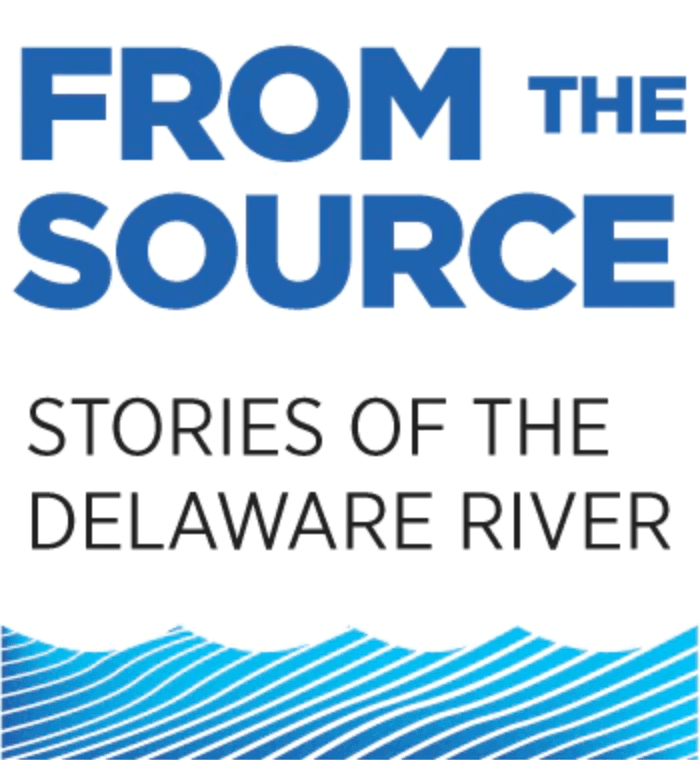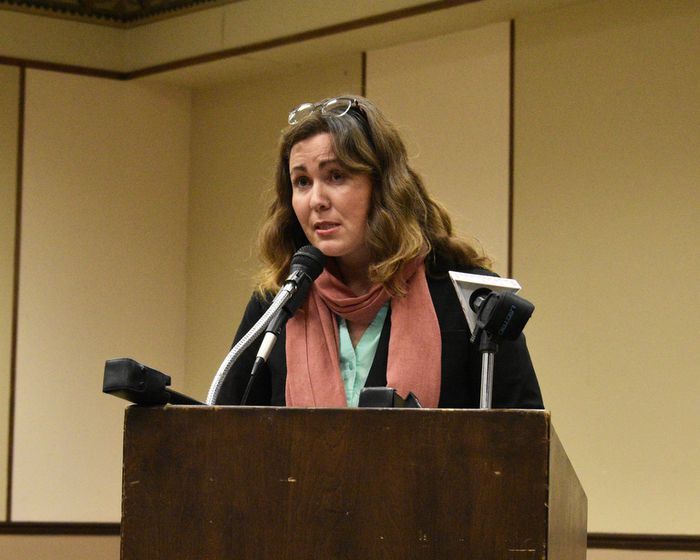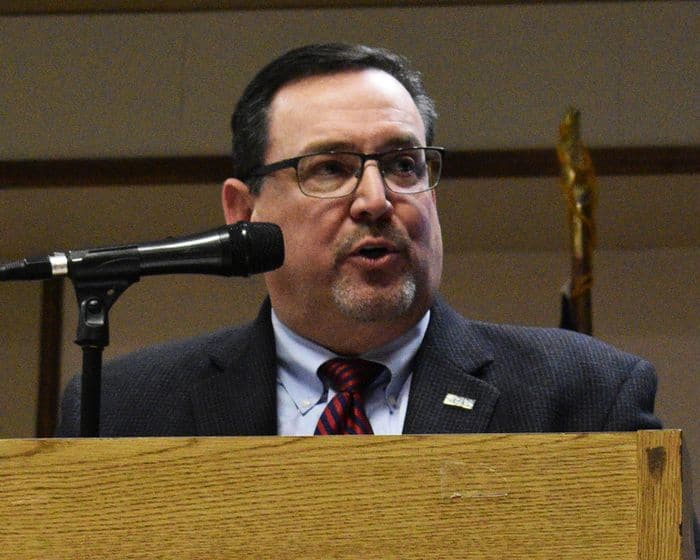500 people pack meeting on using Lehigh River dam to combat drought
This article was originally published in lehighvalleylive.com, one of our "From the Source" collaborators.
A crowd estimated at about 500 people packed a meeting Thursday night on whether Francis E. Walter Dam on the Lehigh River can play a new role in combating drought impacts projected to worsen due to climate change.
Anglers and whitewater rafting companies asked for assurances the plan would not jeopardize the role of the Pocono Mountains dam in supporting recreation. That’s one of its missions now, secondary to flood protection.
Perhaps drawn by suspicions about New York City’s role in funding half of the three-year, $3 million study, the crowd was vocal about its passion for the river and the $37 million tourism industry it supports in Carbon County. But the session held outside White Haven, about 5 miles from the dam itself, proceeded cordially with study participants describing their efforts and the public given an hour to vent their concerns.
Photos of Francis E. Walter Dam, meeting participants, and speakers by Kurt Bresswein | For lehighvalleylive.com
Photos of Francis E. Walter Dam, meeting participants, and speakers by Kurt Bresswein | For lehighvalleylive.com
Photos of Francis E. Walter Dam, meeting participants, and speakers by Kurt Bresswein | For lehighvalleylive.com
Photos of Francis E. Walter Dam, meeting participants, and speakers by Kurt Bresswein | For lehighvalleylive.com
Photos of Francis E. Walter Dam, meeting participants, and speakers by Kurt Bresswein | For lehighvalleylive.com
Photos of Francis E. Walter Dam, meeting participants, and speakers by Kurt Bresswein | For lehighvalleylive.com
Photos of Francis E. Walter Dam, meeting participants, and speakers by Kurt Bresswein | For lehighvalleylive.com
“Tonight, right now, I’m advocating for a spirit of cooperation,” said John Mosovsky, a member of the board of directors at the Lehigh Coldwater Fishery Alliance. “I find all this very exciting, but also very complicated. I don’t believe there is one person in this room that fully understands all the complexities of this project. And so we need each other and all the gifts and talents of each person in this room for its success.”
Located 77 miles upstream of the Lehigh’s confluence with the Delaware River at Easton, the Francis E. Walter Dam is a tool in the management of the Delaware River Basin. The U.S. Army Corps of Engineers project was completed in 1961 and is credited with having prevented $233 million in flood damages. Congress in 1988 added recreation as an officially authorized purpose, to support fishing and boating downstream and in the impound itself that boasts multiple boat launches and picnic areas.
Water is released from the dam to support fish habitat and whitewater rafting based on a Flow Management Plan completed in 2005 by the Army Corps of Engineers Philadelphia District, in partnership with citizens and businesses with a stake in the river’s flow and the Pennsylvania Fish and Boat Commission and Department of Conservation and Natural Resources. Central to the plan is building up, each spring, the elevation of water impounded by the dam to 1,370 feet above sea level.
During a drought declaration, the Delaware River Basin Commission can request storage up to 1,392 feet, according to the Lehigh Coldwater Fishery Alliance, a group formed in 2005 to advocate for optimal dam releases “to improve overall flows, protect habitat and enhance the Lehigh River’s wild trout fishery.”
This new “Francis E. Walter Dam Reevaluation Study” was requested by the Basin Commission to explore possibly enhancing its role in emergency drought storage, as authorized by the Water Resource Development Act of 2014, said Dan Caprioli, strategic planner with the Army Corps of Engineers.
“We’re not interested in eliminating whitewater releases or reducing the plan. If anything we’re trying to improve that, we’re looking for ways to optimize that: Can we store water longer, release water further throughout the year, provide additional releases … ‚” Caprioli said during Thursday night’s meeting at Mountain Laurel Resort. Or when “we do this flood study we find out we have a little bit of extra room in there, maybe we can release water longer than we could in the past. So we’re going to look at that.”
Why New York City is involved
The New York City Department of Environmental Protection agreed to help fund the study to see if Francis E. Walter can help push back saltwater creeping up the Delaware Estuary during drought conditions.
New York City owns and operates three large reservoirs on the headwaters of the Delaware River, part of a network of 19 reservoirs providing drinking water to 9.6 million people. Last year, the city piped 208 billion gallons to its customers and sent 293 billion gallons down the Delaware River to support cold-water fish habitat, fight flooding and meet established flow targets, said Paul Rush, who oversees operation, maintenance and protection of New York City’s water supply system as deputy commissioner for the NYCDEP Bureau of Water Supply. That’s based on a reservoir management plan that has evolved from the days of keeping the city’s impounds at their maximum, in what Rush called the days of “fill and spill.”
He admitted he was surprised by Thursday’s crowd, and was interrupted at one point by a man in the audience shouting, “Yeah, we’re worried that you’re here at all.”

“We’re not interested in taking drinking water out of the F.E. Walter, we’re not interested in directing the operations or purchasing space or ending recreational releases that support tourism and the local economy,” Rush said. “I understand the cold-water fisheries, I understand the whitewater rafting. People’s lives are around there, livelihoods are affected. And when someone starts talking about things that could possibly impact livelihoods, that gets personal and that gets people out here tonight to hear what’s really going on.”
Water released from the city’s reservoirs to repel saltwater creeping up the Delaware River during drought can take nearly a week to reach what is called the salt front, Rush said. That might not be efficient or sufficient enough to keep saltwater out of drinking water supplies downstream in the worst drought, he said.
“As the climate changes and ocean levels continue to rise, we know the saltwater from the Atlantic will push farther north into the Delaware River,” he said. “During droughts the intrusion of saltwater from the ocean known as the salt front could stress natural ecosystems and put drinking water supplies at risk.”
Commenters on Thursday challenged New York City in addressing its own infrastructure needs first before looking to the Poconos for help, including repairing leaks in the Delaware Aqueduct that the NYCDEP estimates spill between 15 million and 35 million gallons of water per day.
State Sen. Lisa Baker, a northeastern Pennsylvania Republican, said many of her constituents want to know New York City isn’t wasting precious water due to poor infrastructure. She joined state Rep. Doyle Heffley, R-Carbon, in pressuring the Francis E. Walter Dam study participants to prioritize the local region over New York City or the lower Delaware River.
“What is the long-range contingency plan if water is released and then a drought happens here in our region, who helps counter our water emergency?” Baker asked. “And who will be submitting questions, concerns in the future? We want to know that once a plan is put in place, will the non-federal match funders — the DRBC or the City of New York — have any special rights to override the recommendations made in that plan.”
‘Very early in the process’
The study participants stressed the effort just started in September, with a goal of reaching a final report in September 2022. Milestones along the way include tentatively selecting a plan by this fall, with another public session in October or November, followed by a spring 2021 public meeting on the study’s draft report. Congress would have to approve any operational or structural changes for the dam, said Steve Tambini, executive director of the Delaware River Basin Commission.
“This is very early in the process,” Tambini said, defending the study later in saying: “Short-term weather patterns and longer term climate patterns are changing, affecting the water cycle in the basin, and it’s prudent to begin and evaluate and plan for the impacts the basin may experience in the future.”
Alternatives being considered for the dam include raising the elevation of the dam and putting in a new tower with the ability to draw and release water at different elevations — in other words to provide colder water releases at key times, according to the Army Corps of Engineers.
“Ultimately we can come out of this study with a win-win solution for everybody, all the stakeholders,” said Paul Blum, Planning Division chief at the Army Corps of Engineers.
Jerry McAward, president of Jim Thorpe River Sports Inc., Northeast PA Kayak School Inc. and the new Lehighton Outdoor Center LLC, asked that the 1,370-foot pool behind Francis E. Walter Dam remain “intact and unassailable.” The Flow Management Plan that established that benchmark was a decade in the making, commented Ken Powley, owner of Whitewater Challengers and representing the Lehigh River Outfitters Association.
“This plan works,” Powley said. “It works for fishing, it works for boating. … I guess what I’m hoping to hear is an assurance that … the study partners are committed to not studying alternatives that would jeopardize or diminish the recreational or water quality values of the Lehigh River.”
Amber Breiner, executive director of the Carbon County Community Foundation, told the study participants Thursday night a petition had drawn 1,750 signatories in favor of putting local needs first in any revision of the Flow Management Plan.
Daryl Pierce, a fisheries biologist with the Pennsylvania Fish and Boat Commission, commented that the study could be a real positive for improving fish habitat both in the dam impound and downstream in the Lehigh River: “We are going to approach this with that glass-half-full perspective,” he said.
Robert Shane, Mid-Atlantic organizer for Trout Unlimited, said the study offers the potential to enhance a wild brown trout habitat that has made the upper Lehigh a destination for anglers.
“We all love the Lehigh,” said McAward. “What I would like to suggest is that we all stay engaged. This is the beginning of the process.”
Learn more
The U.S. Army of Corps of Engineers has further information on the “Francis E. Walter Dam Re-evaluation Study” available at www.nap.usace.army.mil.









